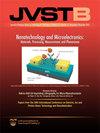温度对门控硅场发射阵列性能的影响
IF 1.4
4区 工程技术
引用次数: 6
摘要
硅场发射极阵列(Si FEAs)是一种用于高温电子器件的真空通道晶体管的电子源。研究了在25 ~ 400℃不同温度下,在直流栅极偏置为40 V、发射电流为1.3 mA时,1000 × 1000硅尖基门控场发射体阵列的电特性。在~ 350°C时,残余气体分析仪的测量结果表明,水解吸和二氧化碳分压显著增加,栅极到发射极的泄漏电流减少了十倍以上,集电极电流增加了十倍以上。这些改进在热处理后仍然存在,但一旦装置暴露在大气中几天,这些改进就会消失。这种改善可以通过额外的烘烤来恢复,这表明表面上的吸附物(主要是水)影响了场发射和表面泄漏。还发现,热处理后,器件的电特性在40 V时集电极电流的变化<3%,这(不暴露于大气中)可以被称为弱温度依赖性。这些结果表明Si FEAs作为高温晶体管是可行的。本文章由计算机程序翻译,如有差异,请以英文原文为准。
Temperature effects on gated silicon field emission array performance
Silicon field emitter arrays (Si FEAs) are being explored as an electron source for vacuum channel transistors for high temperature electronics. Arrays of 1000 × 1000 silicon tip based gated field emitters were studied by measuring their electrical characteristics up to 40 V of DC gate bias with a 1.3 mA emission current at different temperatures from 25 to 400 °C. At ∼350 °C, residual gas analyzer measurements show that water desorption and carbon dioxide partial pressures increase significantly, the gate to emitter leakage current decreases by more than ten times, and the collector current increases by more than ten times. These improvements remained after heat-treatment but were then lost once the device was exposed to the atmosphere for several days. The improvements could be recovered upon additional baking suggesting that adsorbates (primarily water) on the surface affected field emission and surface leakage. It was also found that after heat-treatment, the electrical characteristics of the devices exhibited <3% variation in collector current at 40 V, which (without exposure to the atmosphere) can be termed as a weak temperature dependence. These results suggest that Si FEAs could be viable as a high temperature transistor.
求助全文
通过发布文献求助,成功后即可免费获取论文全文。
去求助
来源期刊

Journal of Vacuum Science & Technology B
工程技术-工程:电子与电气
自引率
14.30%
发文量
0
审稿时长
2.5 months
期刊介绍:
Journal of Vacuum Science & Technology B emphasizes processing, measurement and phenomena associated with micrometer and nanometer structures and devices. Processing may include vacuum processing, plasma processing and microlithography among others, while measurement refers to a wide range of materials and device characterization methods for understanding the physics and chemistry of submicron and nanometer structures and devices.
 求助内容:
求助内容: 应助结果提醒方式:
应助结果提醒方式:


